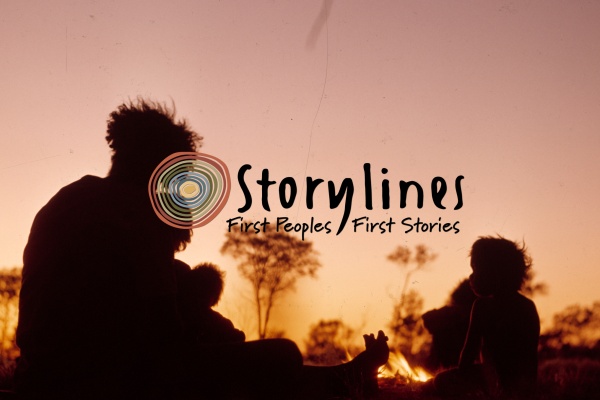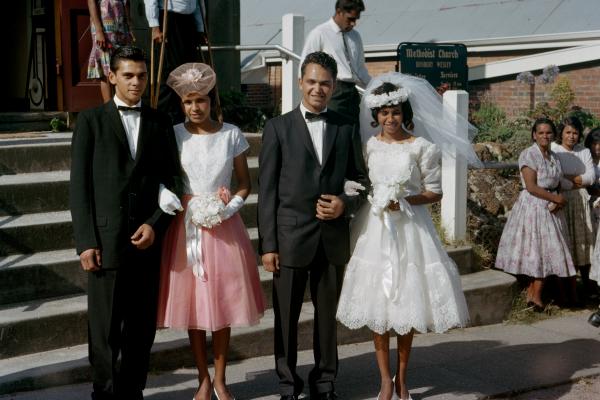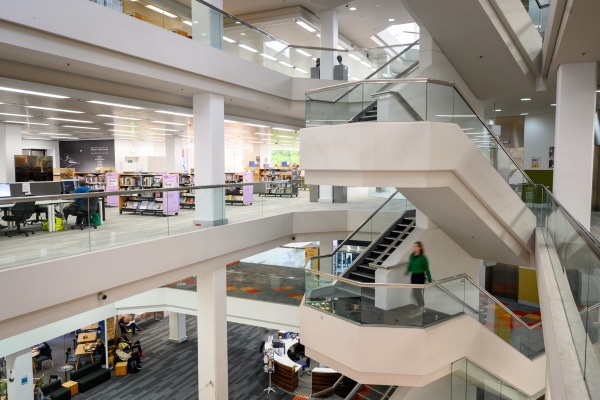
The State Library of Western Australia acknowledges the traditional owners of Country throughout Western Australia and their continuing connection to land and culture. We pay our respects to Elders past and present.
The State Library is honoured to be located on Whadjuk Country, the ancestral lands of the Noongar people.
My Boodja, My Turtle Dreaming by Joanne Parfitt (artist name is Bungaan) was specially created for a new Acknowledgment of Country wall to welcome visitors to the State Library and provide a deeper understanding of the land we live on. You can find the wall on the Ground Floor opposite the Welcome Desk.
Artist's Statement
My Boodja, My Turtle Dreaming by Joanne Parfitt, 2024
My name is Joanne Parfitt.
My artist name is Bungaan.
This name was passed down to me from my Auntie Audrey Boundry, who was also an artist and taught me.
My Country is Whadjuk through my dad’s side, and Ballardong through my mum’s side. I was born in Swan Districts Hospital, Midland and grew up in Allawah Grove, York and Cloverdale.
I dedicate this painting My Boodja, My Turtle Dreaming to my parents Claude and Violet Parfitt, nee Boundry, and my grandparents Gordon and Vera Boundry, nee Narkle.
Without them, this painting wouldn’t be possible. They taught me the knowledge through stories passed down to me and my brothers, Brett and Harry. I learnt how to paint our Country from watching my mother and grandmother do bark paintings. Now I am passing it down to the next generations, my son Dwayne Parfitt and my grandchildren, Telarah, Sylvarnie (Barney) and Lionel.
Noongars, our knowledge is all around us in the bush, and our stories are passed down by our Elders around the campfire. That has always been our library. Have a look around the bush and see how much knowledge there is. The knowledge is all about connection to our land, rivers and our sea. I am an Elder now, and it is my turn to pass down the knowledge.
Landscape painting is my passion and I love painting the beautiful scenery and our native animals and plants of Whadjuk Nyoongar Country. It is truly beautiful, our Country, and we have to look after and care for it and keep that connection strong for the next generations.
My brother Brett was also a talented painter and our family totem is the long-neck turtle which we both painted a lot. I remember going hunting at Munday Swamp as kids back in the 1970s with my dad and my brothers, our aunties, uncles, cousins and other family members. We lived nearby at Cloverdale, and we were going down there since the Allawah Grove days in the 1960s.
A big mob of us kids with our Elders, we’d go walking down to Munday Swamp and we were djerpin. We used to look forward to it because it was our outing, we were connected to our land. We were walking in our ancestor’s tracks. We lived in the suburbs, but when we went there, it was like we were home. We knew where everything was, where to go, and how to get our food, we’d get witchetty grubs and long-neck turtles, we’d make a little fire and cook it on the ashes. We wasn’t frightened to eat it because Noongars lived off that forever, our bushtucker. We even took our flour and made little dampers, straight on the ashes.
Wintertime, Makuru and Djilba was the main seasons for our hunting and gathering because campfires is our connection to our stories. That’s where we got taught, always around the campfire. The campfire has always been the connection to warmth, food and safety, family and stories.
I am visualising my upbringing, walking through the bush and it was pitch black. Us kids were scared but we’d be safe because we were sitting around the campfire with our parents. Our Elders, I don’t know how they done it, walking through the bush in the dark, and they would sing out, coooeee, and we knew they were coming. Before you knew it, they were around the fire with us. They’d say put the billy on, and we knew what to do. It was the loose Bushells tea, and you’d chuck it in the billy. There was no electricity or gas, we had little kerosene lanterns but mostly our fire was our warmth and our light.
We’d go walking with our sticks, which was our hunting tool. We tapped the dry surface with our sticks until we’d hear it hit the turtle shell. We’d get enough food to feed the families and we’d go back and cook them around the fire and listen to the stories. We’d get a branch off the tree and sweep the ground and build up our campfire perfect. Everybody would be happy, sharing our bush food.
When we were out at Munday Swamp and we were hunting, my dad would also get the bark from the paperbark trees. I would sit with Mum and Nanna and they’d put the bark on the boards, then they would paint the landscape on the bark of my mum’s Country, York. Then us kids would go and sell them to the neighbours in the surrounding area to make extra money for our households. I am still doing it today.
I am grateful that I listened to, and I learnt from my parents, grandparents and my Elders, all the knowledge and stories that I was told I am now passing down to the next generations.
I hope through this painting you will connect to the stories of our Country and learn to understand how we see it. There is a story to every part of our land.
I hope through this painting I have done all the Whadjuk Noongars who share this Country and story proud.
I also hope that other visitors to our Country, seeing this painting will feel welcome too, as we stand on this boodja together.
Auntie Joanne Parfitt
Discover more


